
The Lycopodiaceae are an old family of vascular plants, including all of the core clubmosses and firmosses, comprising 16 accepted genera and about 400 known species. This family originated about 380 million years ago in the early Devonian, though the diversity within the family has been much more recent. "Wolf foot" is another common name for this family due to the resemblance of either the roots or branch tips to a wolf's paw.

Lycopodium is a genus of clubmosses, also known as ground pines or creeping cedars, in the family Lycopodiaceae. Two very different circumscriptions of the genus are in use. In the Pteridophyte Phylogeny Group classification of 2016, Lycopodium is one of nine genera in the subfamily Lycopodioideae, and has from nine to 15 species. In other classifications, the genus is equivalent to the whole of the subfamily, since it includes all of the other genera. More than 40 species are accepted.

Lycopodium clavatum is the most widespread species in the genus Lycopodium in the clubmoss family.

Diphasiastrum is a genus of clubmosses in the plant family Lycopodiaceae. In the Pteridophyte Phylogeny Group classification of 2016, it is placed in the subfamily Lycopodioideae. It is closely related to the genus Lycopodium, and some botanists treat it within a broad view of that genus as a section, Lycopodium sect. Complanata. Some species superficially resemble diminutive gymnosperms and have been given common names such as ground-pine or ground-cedar.

Lycopodiella is a genus in the clubmoss family Lycopodiaceae. The genus members are commonly called bog clubmosses, describing their wetland habitat. The genus has a cosmopolitan distribution, with centers of diversity in the tropical New World and New Guinea. In the past, the genus was often incorporated within the related genus Lycopodium, but was segregated in 1964. In the Pteridophyte Phylogeny Group classification of 2016, Lycopodiella is placed in the subfamily Lycopodielloideae, along with three other genera. In this circumscription, the genus has about 15 species. Other sources use a wider circumscription, in which the genus is equivalent to the Lycopodielloideae of PPG I, in which case about 40 species and hybrids are accepted.
Ground pine or ground-pine may refer to:

Psilotum complanatum, the flatfork fern, is a rare herbaceous epiphytic fern ally in the genus Psilotum. There is some evidence that it might be a true fern that has lost some typically fern-like characteristics. Morphologically, the plant is simple, lacking leaves and roots, and having hanging stems with dichotomous branching, which lack developed leaves but have minute scales. The stems and branches have protostele, with a triangular-shaped core of xylem. The scales are arranged in two rows along the flat stems and branches. The stems are broadly triangular in cross section and 5 mm wide. The branches are 1.5 to 2 mm wide. P. complanatum grows 10 to 75 cm long and stems branch in pairs a number of times up their length and are covered with brownish colored hair-like rhizoids. Small stalks end with simple sporangia from the axils of minute bifid, rounded sporophylls. Bean shaped, monolete spores are produced. The spores germinate best in a dark environment when ammonium is present. The gametophyte is non-photosynthetic, living in association with a fungus for its nutritional needs. Plants grow from a subterranean rhizome which anchors the plant in place and absorbs nutrients by means of filament like rhizoids.

Diphasiastrum complanatum, common names groundcedar, creeping jenny, or northern running-pine, is a species of clubmoss native to dry coniferous forests in colder northerly parts of the world. Under the original name Lycopodium complanatum, this was an inclusive superspecies that included a number of other species now known to be biologically separate.

Lycopodium powder is a yellow-tan dust-like powder, consisting of the dry spores of clubmoss plants, or various fern relatives. When it is mixed with air, the spores are highly flammable and are used to create dust explosions as theatrical special effects. The powder was traditionally used in physics experiments to demonstrate phenomena such as Brownian motion.
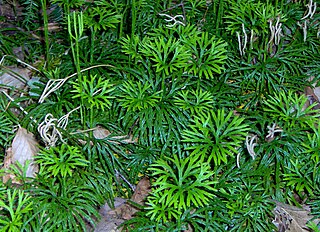
Diphasiastrum digitatum is known as groundcedar, running cedar or crowsfoot, along with other members of its genus, but the common name fan clubmoss can be used to refer to it specifically. It is the most common species of Diphasiastrum in North America. It is a type of plant known as a clubmoss, which is within one of the three main divisions of living vascular plants. It was formerly included in the superspecies Diphasiastrum complanatum. For many years, this species was known as Lycopodium flabelliforme or Lycopodium digitatum.
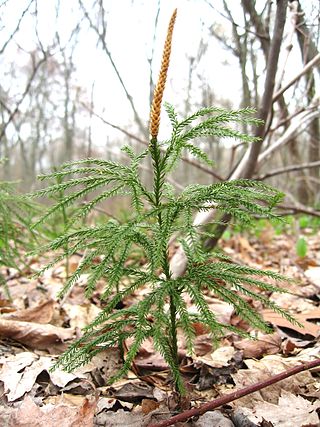
Dendrolycopodium obscurum, synonym Lycopodium obscurum, commonly called rare clubmoss, ground pine, or princess pine, is a North American species of clubmoss in the family Lycopodiaceae. It is a close relative of other species such as D. dendroideum and D. hickeyi, also treelike. It is native to the eastern United States and southeastern Canada from Georgia to Minnesota to Nova Scotia. It grows in the understory of temperate coniferous and deciduous forests, where it is involved in seral secondary succession, growing in clonal colonies some years after disturbance has occurred. It has also been found in Japan, Taiwan, Korea, Russian Far East, and northeastern China.
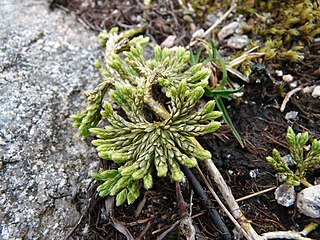
Diphasiastrum alpinum, the alpine clubmoss, is a species of clubmoss. It was first described by Carl Linnaeus in his Flora Lapponica, 1737, from specimens obtained in Finland.

Diphasiastrum sitchense, the Sitka clubmoss, is a pteridophyte species native to northern North America and northeastern Asia. It is a terrestrial herb spreading by stolons running on the surface or the ground or just slightly below the surface. Leaves are appressed, broadly lanceolate, up to 3.2 mm long. Strobili are solitary on the ends of shoots. It is known from every province in Canada, plus the US States of Alaska, Oregon, Washington, Idaho, Montana, Maine, New Hampshire, Vermont, and New York. It is also found in Greenland, St. Pierre and Miquelon, Yukon, Japan, and the Kamchatka Peninsula of Asiatic Russia. It can be found in alpine meadows, open rocky barrens, and coniferous woodlands.
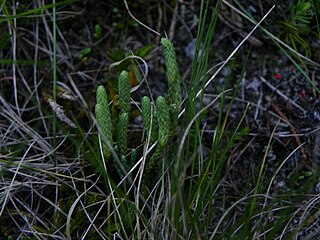
Diphasiastrum × issleri, known as Issler's clubmoss, is a hybrid species of clubmoss known from northern Europe and a few historical collections in northern Maine.
Diphasiastrum × sabinifolium, the savinleaf groundpine or savin leaf club moss, is hybrid of D. sitchense and D. tristachyum. It can be found in North America from Labrador and Newfoundland to Ontario, and south to Pennsylvania and Michigan. Erect stems can reach 20 centimeters high, and branch dichotomously. The sterile branches are flattened, and the leaves are 4-ranked. Peduncles are 1-8 centimeters long. In many disturbed sites, it can be found growing alongside D. sitchense, and can be distinguished by flattened branchlets split into four ranks, as opposed to those of D. sitchense, which generally are rounded and split into five ranks.
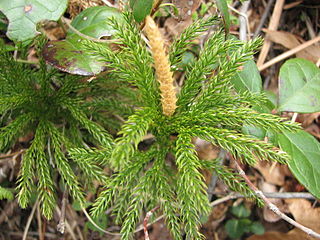
Dendrolycopodium hickeyi known as Hickey's tree club-moss or Pennsylvania clubmoss, is a North American species of clubmoss in the family Lycopodiaceae. It is native to eastern and Central Canada and the eastern and north-central United States. The genus Dendrolycopodium is accepted in the Pteridophyte Phylogeny Group classification of 2016, but not in other classifications, which submerge the genus in a larger Lycopodium.

Lycopodioideae is a subfamily in the family Lycopodiaceae in the Pteridophyte Phylogeny Group classification of 2016. It is equivalent to a broad circumscription of the genus Lycopodium in other classifications. Like all lycophytes, members of the Lycopodioideae reproduce by spores. The oldest fossils of modern members of the family date to the Early Cretaceous.
















